Ram
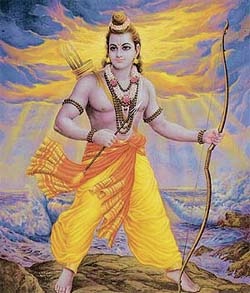
Ram is the 7th incarnation of Vishnu and the central figure of the Ramayana (Ramayan) epic. The Ramayan is the very soul of India. It is a complete guide to God-realization, the path to which lies in righteousness. The ideals of man are beautifully portrayed in it. Everyone should emulate those ideals and grow into ideal human beings and ideal citizens.
Ram took birth to free the earth from the cruelty and sins of the demon King Ravana (Ravan). Ravana had practiced austerities in order to propitiate Shiva and Brahma, who had granted him immunity from being killed by gods, gandharvas or demons. One of the gods had to take on a human form in order to be able to defeat Ravana.
Ram took birth to free the earth from the cruelty and sins of the demon King Ravana (Ravan). Ravana had practiced austerities in order to propitiate Shiva and Brahma, who had granted him immunity from being killed by gods, gandharvas or demons. One of the gods had to take on a human form in order to be able to defeat Ravana.
Hanuman
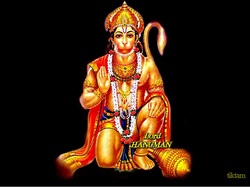
Some say Hanuman was born as the son of the King and Queen of the Monkeys. To others, he is the son of Anjana, an female Apsara who had been transformed into a monkey by a curse, and Vayu, the wind god. It is also said that from his father Vayu Hanuman received the ability to fly.
Hanuman, the mighty ape that aided Lord Rama in his expedition against evil forces, is one of the most popular idols in the Hindu pantheon. Believed to be an avatar of Lord Shiva, Hanuman is worshiped as a symbol of physical strength, perseverance and devotion. Hanuman's tale in the epic Ramayana - where he is assigned the responsibility to locate Rama's wife Sita abducted by Ravana, the demon king of Lanka — is known for its astounding ability to inspire and equip a reader with all the ingredients needed to face ordeals and conquer obstructions in the way of the world.
Hanuman, the mighty ape that aided Lord Rama in his expedition against evil forces, is one of the most popular idols in the Hindu pantheon. Believed to be an avatar of Lord Shiva, Hanuman is worshiped as a symbol of physical strength, perseverance and devotion. Hanuman's tale in the epic Ramayana - where he is assigned the responsibility to locate Rama's wife Sita abducted by Ravana, the demon king of Lanka — is known for its astounding ability to inspire and equip a reader with all the ingredients needed to face ordeals and conquer obstructions in the way of the world.
Shiv
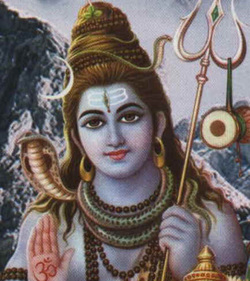
Shiva is the god of the yogis, self-controlled and celibate, while at the same time a lover of his spouse (shakti). Lord Shiva is the destroyer of the world, following Brahma the creator and Vishnu the preserver, after which Brahma again creates the world and so on. Shiva is responsible for change both in the form of death and destruction and in the positive sense of destroying the ego, the false identification with the form. This also includes the shedding of old habits and attachments. All that has a beginning by necessity must have an end. In destruction, truly nothing is destroyed but the illusion of individuality. Thus the power of destruction associated with Lord Shiva has great purifying power, both on a more personal level when problems make us see reality more clearly, as on a more universal level. Destruction opens the path for a new creation of the universe, a new opportunity for the beauty and drama of universal illusion to unfold. As Satyam, Shivam, Sundaram or Truth, Goodness and Beauty, Shiva represents the most essential goodness.
Budhha
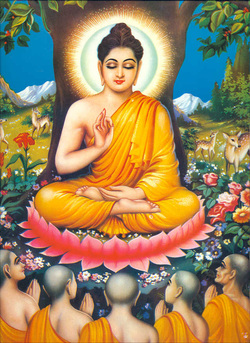
In Hinduism, Buddha is regarded as the ninth incarnation of Vishnu, following Ram and Krishna. That is obviously a real honour, even though Buddhism may not see it that way. Buddhism in fact does not believe in Gods and sees him only as the incarnation of a realized being. Nevertheless, various forms of Buddha are worshipped in Buddhism in ways that are very similar to the worship of Hindu gods. One example is the Amithaba Buddha, seen as the main bodhisattva form of the fire element, which is symbolized by the deity and the according deities, called the lotus family. The fire element as red color symbolizes the western region of the universe and has the lotus or nectar vase as it's symbol. The lotus stands for pure intentions of all activities and the nectar vase, filled with subtle life energy, symbolizes the immense power of this element. The Amithaba Buddha embodies wisdom and essential equality. The Amithaba Buddha is a form of Buddha that represents infinite light. He is the embodiment of the enlightened speech of all Buddha's. The Amithaba Buddha is the principal representative of the blissful pure land of the West.
Another example is the Shakyammuni Buddha, the fourth of 1000 founding buddha's predicted to appear during the coming eon. The purpose of the Shakyamunni Buddha is to reveal the path leading to full enlightenement.
Another example is the Shakyammuni Buddha, the fourth of 1000 founding buddha's predicted to appear during the coming eon. The purpose of the Shakyamunni Buddha is to reveal the path leading to full enlightenement.
Jagannath
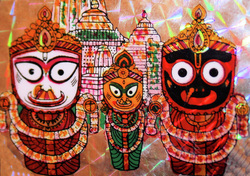
Jagannath, Lord of the world, is the name given to a particular form of Vishnu, or more accurately, that of Shree Krishna. The image of this God has no legs, and only stumps of arms. Together with Jagannath (Krishna) are seated his brother Balram and sister Subhadra. The later two images also do not have legs and hands.
These three images are worshipped in the same form in all the Jagannath temples, situated mostly in the eastern parts of India. But Puri, near the town of Cuttack, in the sate of Orissa, is considered to be the real abode of Lord Jagannath and the chief center of its worship is a great temple complex in that city. Three big statues of Shree Krishna, Balram and Subhadra are enshrined in this temple.
These three images are worshipped in the same form in all the Jagannath temples, situated mostly in the eastern parts of India. But Puri, near the town of Cuttack, in the sate of Orissa, is considered to be the real abode of Lord Jagannath and the chief center of its worship is a great temple complex in that city. Three big statues of Shree Krishna, Balram and Subhadra are enshrined in this temple.
Venkatesh
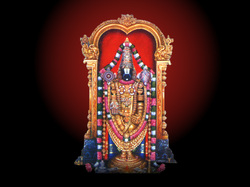
The Hindu Trinity, forms of Gods and Goddesses, the Avatars of Lord Vishnu, the Devatas, Planet and Animal Deities are all presented with their image representation.
Venkateshwara (Venkateshwer or Venkatachalapathi) is another form of Lord Vishnu who is also very popular as a Hindu deity. He is also known as Balaji or Bithala.
He has a dark complexion and four hands. In his two upper hands he holds a discus (a symbol of power) and a conch s hell (a symbol of existence). With his lower hands extended downward he asks devotees to have faith and surrender to him for protection.
The ancient and sacred temple of Sri Venkateswara is located on the seventh peak Venkatachala of the Tirupathi Hill (Thirumala), which lies in the AndhraPradesh State of India (South India).The temple of Sri Venkateswara has acquired unique sanctity in Indian religious lore. The Sastras, Puranas, Sthala Mahatyams and Alwar hymns unequivocally declare that, in the Kali Yuga, one can attain mukti, only by worshipping Venkata Nayaka or Sri Venkateswara
Venkateshwara (Venkateshwer or Venkatachalapathi) is another form of Lord Vishnu who is also very popular as a Hindu deity. He is also known as Balaji or Bithala.
He has a dark complexion and four hands. In his two upper hands he holds a discus (a symbol of power) and a conch s hell (a symbol of existence). With his lower hands extended downward he asks devotees to have faith and surrender to him for protection.
The ancient and sacred temple of Sri Venkateswara is located on the seventh peak Venkatachala of the Tirupathi Hill (Thirumala), which lies in the AndhraPradesh State of India (South India).The temple of Sri Venkateswara has acquired unique sanctity in Indian religious lore. The Sastras, Puranas, Sthala Mahatyams and Alwar hymns unequivocally declare that, in the Kali Yuga, one can attain mukti, only by worshipping Venkata Nayaka or Sri Venkateswara
Krishna
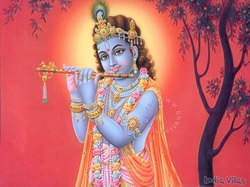
The birth of Krishna is in itself a transcendental phenomenon that generates awe among the Hindus and overwhelms one and all with its supra mundane happenings.
Mother Earth, unable to bear the burden of sins committed by evil kings and rulers, appealed to Brahma, the Creator for help. Brahma prayed to the Supreme Lord Vishnu, who assured him that he would soon be born on earth to annihilate tyrannical forces.One such evil force was Kamsa, the ruler of Mathura (in northern India) and his people were utterly terrified of him. On the day Kamsa's sister Devaki was married off to Vasudeva, an akashvani or voice from the sky was heard prophesying that Devaki's 8th son would be the destroyer of Kamsa. The frightened Kamsa immediately unsheathed his sword to kill his sister but Vasudeva intervened and implored Kamsa to spare his bride, and promised to hand over every new born child to him. Kamsa relented but imprisoned both Devaki and her husband Vasudeva.
Mother Earth, unable to bear the burden of sins committed by evil kings and rulers, appealed to Brahma, the Creator for help. Brahma prayed to the Supreme Lord Vishnu, who assured him that he would soon be born on earth to annihilate tyrannical forces.One such evil force was Kamsa, the ruler of Mathura (in northern India) and his people were utterly terrified of him. On the day Kamsa's sister Devaki was married off to Vasudeva, an akashvani or voice from the sky was heard prophesying that Devaki's 8th son would be the destroyer of Kamsa. The frightened Kamsa immediately unsheathed his sword to kill his sister but Vasudeva intervened and implored Kamsa to spare his bride, and promised to hand over every new born child to him. Kamsa relented but imprisoned both Devaki and her husband Vasudeva.
